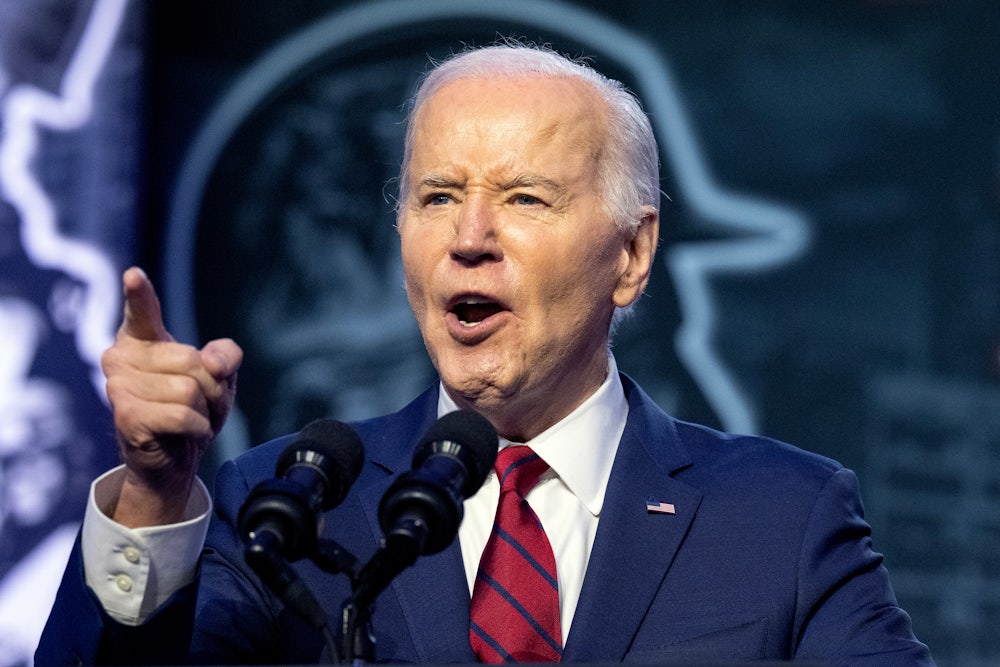April 23 marked a defining moment for the Biden administration, a watershed of multiple significant actions to protect the interests of working people. We know, from Michael D. Shear of The New York Times, among others, that Biden has been on a tear lately “to try to shore up his support among key constituencies” with regulatory actions. But it’s not clear whether the convergence, on a single day, of these specific policy announcements—most but not all of them from the Labor Department—was planned or merely coincidental.
The individual components were announced by the Biden administration and covered by the press as isolated and wholly independent. If the timing was coordinated, I’d have expected the White House press office to draw attention to it. But Democratic presidents tend to fear antagonizing too directly the people that Theodore Roosevelt (a Republican!) called “malefactors of great wealth.” Maybe that explains the silence. In any event, April 23 was a sort of Black Tuesday for management. I hope Democrats have the good sense to let working-class voters in on this secret because, as I argued recently (“Yes, Joe Biden Can Win the Working Class Vote”), Biden can’t secure a second term with college graduates alone.
Here’s what happened on management’s Black Tuesday:
- Lael Brainard, director of the White House National Economic Council, and Acting Labor Secretary Julie Su launched an initiative to pressure pension fund managers to require companies in their portfolio not to contest union drives. This was couched in vague euphemistic language about “strong labor commitments” agreed to voluntarily, but as Lauren Kaori Gurley observed in The Washington Post, the federal government sets rules for private pension funds and strongly influences state-administered public pension funds. So, this is potentially significant. If you, dear reader, are conservative, and believe government shouldn’t interfere in a private business’s decision whether to fight an organizing drive, please know that in Southern states, Republican officeholders are starting to pass laws that withhold tax breaks or other state subsidies from companies that recognize unions voluntarily. (More here.) Let’s also recall that the National Labor Relations Act states in its preamble that “encouraging the practice and procedure of collective bargaining” is “declared to be the policy of the United States.”
- The Labor Department finalized its regulation, proposed last October, that requires financial professionals, when advising customers on retirement accounts, to act as fiduciaries. That means your broker must consider only your financial interest and not, for instance, any commissions or fees he might collect. This falls into the category of “common sense rules you assumed were already in place, but aren’t, because the business world is even skeevier than you imagined.” The White House Council of Economic Advisers has calculated that conflicts of interest concerning just one retirement product—fixed annuities—generate up to $5 billion annually in losses. The Obama administration issued a similar rule in 2016 that was vacated by the Fifth Circuit of Appeals; the new rule has been altered to address that reactionary court’s ruling, on the (admittedly shaky) presumption that the Fifth Circuit is amenable to reason.
- The Federal Trade Commission banned non-compete clauses in employment contracts, which have proliferated in recent years as a means to prevent (as Senator Bernie Sanders pointed out Tuesday) even low-wage workers like Starbucks baristas from seeking employment with a competitor. Non-competes have become a widely deployed management trick to limit turnover by closing off the avenues to alternative employment opportunities. There are, to be sure, legitimate reasons to prevent certain high-ranking company officials from taking proprietary secrets to another firm. But remember when your mother used to say, “This is why you can’t have nice things”? Non-competes were abused over and over again until finally the government could no longer trust businesses to apply them legitimately. The FTC concluded, in banning non-competes, that existing trade secret laws and non-disclosure agreements should provide sufficient protection to firms that don’t want to tip off competitors to trade secrets.
- The Labor Department issued a final rule expanding overtime coverage to 4.3 million additional workers.
The overtime rule was the most important action the Biden administration took on management’s Black Tuesday, and it’s a little complicated, so I’m going to address it at some length.
The essence of the overtime rule is the preservation of the 40-hour work week, which is one of those New Deal legacies that’s been allowed to erode over time. Ever since 1940, the Fair Labor Standards Act has barred managers from working employees more than 40 hours in a given week unless the boss pays time-and-a-half. The idea was to create a financial disincentive for businesses to extend the work week beyond 40 hours, which was judged unhealthful, and to reward employees handsomely when they put in the extra hours.
The value of a 40-hour week had been recognized as far back as 1869, when President Ulysses S. Grant (another Republican!) mandated an eight-hour workday for all federal employees. Henry Ford, in 1926, having discovered that you got more work out of somebody when you treated him like a human being, gave factory workers two days of rest instead of the Biblical one, and likewise limited their work day to eight hours, thereby reducing their work week to 40 hours (down from the previous 60). Labor unions played no small role in creating the 40-hour week; the 1886 labor protest in Chicago known as the Haymarket Square Riot, which led to the establishment of Labor Day, began as a rally to support workers striking for an eight-hour work day. Frances Perkins accepted the job of labor secretary from President Franklin Roosevelt on condition that, among other things, the federal government put a floor under wages and a ceiling over hours worked. The Fair Labor Standards Act, or FLSA, delivered on that promise.
The 1938 law, as revised in 1940, exempted from the 40-hour limit executive, administrative, and professional employees, creating the problem of deciding which workers fit that category. The imperfect answer is something called a “duties test,” which looks at what sort of work an individual performs. As you might guess, businesses dream up all sorts of diabolical ways to claim a maximum number of their employees as executive, administrative, or professional. To limit such shenanigans, the Labor Department stipulates that anybody who is paid less than x qualifies automatically for time-and-a-half overtime pay—duties test or no duties test.
For decades after the FLSA’s passage, the Labor Department conscientiously increased x at regular intervals to keep this wage ceiling in line with inflation. In 1940, x was $50 per week for professionals, the slipperiest of the three exempt categories. After inflation, that was the equivalent, today, of $1,124 per week, or just a whisker below today’s median weekly wage ($1,139). A 40-hour work week was guaranteed not just to the lowest-paid employees, but also to the middle class. By 1975, x was $155 per week for executives and administrators and $170 per week for professionals, a high enough ceiling to extend the 40-hour week to 65 percent of all salaried employees. In 1975—the year Saigon fell and Saturday Night Live debuted—most salaried workers in the United States qualified for overtime pay.
It didn’t last. To the long list of items that went south during the 1970s—heavy industry, the dollar, Main Street, liberalism, literary culture—add the 40-hour work week. The Labor Department stopped increasing x—at first (ironically) because inflation was out of control, later because Ronald Reagan was president, and still later because the Clinton administration somehow never got around to righting this listing ship. Consequently, the proportion of salaried employees who qualified automatically for overtime pay fell to the point where the 40-hour week was no longer a middle-class benefit; it was a poverty benefit, and you had to be extremely poor to qualify. President George W. Bush finally updated overtime rules in 2003, raising x to an annual $23,660, but that was a poverty wage even two decades ago, and because of changes to the duties test, the net effect was that an estimated six million workers lost overtime coverage. By 2015, the proportion of salaried workers who qualified for overtime pay automatically was a mere 8 percent.
In 2016, the Obama administration stepped in, more than doubling x to $47,476 and mandating automatic raises in the future tied to inflation. That didn’t restore the status quo of 1975, when most salaried workers qualified for overtime. But it did increase overtime coverage from 8 percent of salaried workers to 33 percent. You may not recall getting paid overtime in 2017, when the Obama rule was set to take effect. That may be because a district court in Texas invalidated it, and the Trump administration subsequently declined to appeal. So x remained a measly $23,660. The Trump administration in 2019 nudged x up grudgingly to $35,568, and did not mandate future automatic raises.
The Biden proposal will increase x to $58,656 as of January 1. That’s only a couple of thousand less than Obama’s x when you factor in inflation. Obama’s overtime rule was projected to extend coverage to about five million salaried workers; Biden’s is projected to extend it to about four million. Biden’s proposal also mandates automatic raises in the future tied to inflation, though on a slightly less generous basis than Obama’s proposal. These tweaks, and additional ones, are calculated to address a future court challenge. Whether the Fifth Circuit will bite is anybody’s guess.
In the meantime, Biden has restored the 40-hour work week to the middle class for the first time since the 1970s. The median weekly wage in the United States is $1,139. On an annualized basis, that’s $59,228, or just slightly higher than Biden’s eligibility ceiling. That means workers paid very close to the median wage will qualify for time-and-a-half when they work more than 40 hours per week.
The new overtime rule is just about the perfect expression of what Biden calls “middle-out” economics, and workers will start to feel that as early as July, when an interim x of $43,888 will take effect. You like more workers getting paid overtime? Democrats can say. Wait till even more of you get paid overtime two months after you reelect Joe Biden. “Government must have some control over maximum hours,” FDR told Congress in 1937. Thanks to Roosevelt, it does, and now Biden is exercising that control. If Donald Trump wants to, he can run against the 40-hour work week in 2024. I hope he does, because that’s a seriously dumb strategy for a GOP that purports to represent the working class. Even if he doesn’t, Democrats need to spread the word: If the boss works you more than 40 hours, he probably can’t dodge paying time-and-a-half, something he managed to do far too often in the past, because the government didn’t care. Now it cares.










